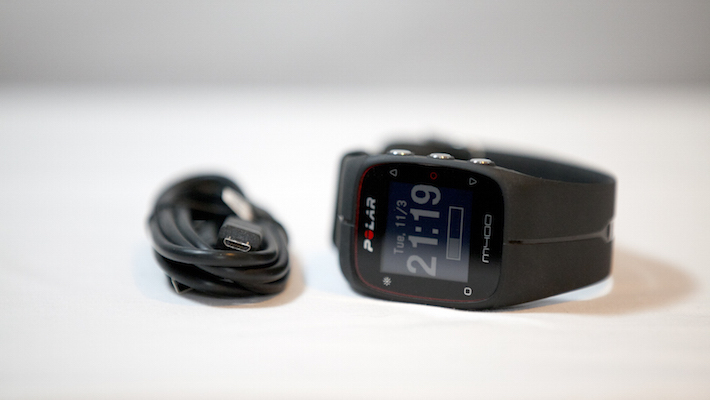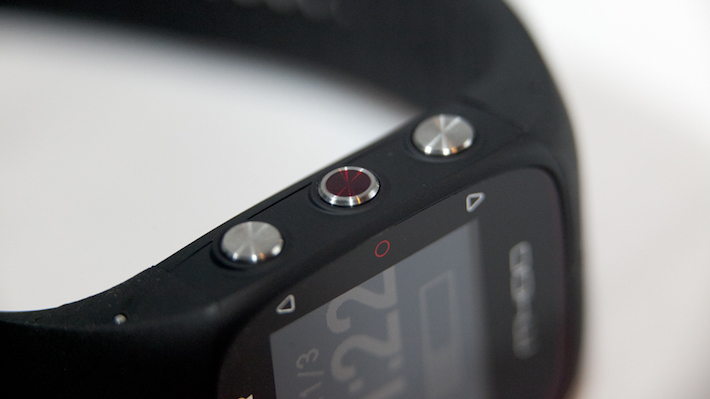Last month I wrote an article about how I learned to appreciate fitness technology, in which I generally addressed the merits of the Polar M400 GPS Running Watch. In this article, I break down the features of the watch for readers who might be interested.
All photos by Jorge Figueiredo.
The M400 GPS Running Watch is a sleek-looking piece of wearable technology. It is a single unit with a stiff, durable, and easily adjustable wristband. Relatively light (just under 57g), and slim (just under 12mm), the band becomes more pliable when it warms up during physical activity (I’ve been using the watch for a month with no sign of any tearing). The interface (for charging and syncing with a computer) is an uncovered micro-USB port on the back, which was a bit disconcerting until I realized that it’s water resistant to 30m and only needs to be dry to be used. An earlier version of the watch had a rubber cover, but it was eventually removed due to the fact that it was not required.
The large, easy-to-read face (128×128 pixel resolution) boasts an informative display that is legible in sunlight and can be backlit with the press of a button when required. In “passive” mode, the watch displays time, an activity bar, the date, and the battery meter; in “active” mode, the watch can show an impressive array of statistics, including heart rate, lap time, and total time. The buttons are large and widely spaced, so activating them is easy even while wearing a thin pair of gloves, which is obviously important when you go running in the cold in Canada.
While the Polar M400 is technically a “GPS running watch,” it could probably be classified as a multi-sport tracking watch given its monitoring acumen. Like a fitness band, the M400 tracks simple daily trends like steps taken and moments of inactivity. It is also much more effective than fitness bands at monitoring sleep, since it’s smart enough to figure out when you actually go to sleep without you having to manually tell it. The M400 has more advanced functionality, such as GPS tracking, that enables you to get more accurate information from your focused activities, especially when wearing the Polar H7 heart rate monitor.
Setting up the watch is easy and takes only a few minutes. Once done, the watch starts doing its thing, tracking your activity level and informing you when you have been inactive for too long. It’s a handy feature that will remind you to keep your heart rate above a certain baseline. Should you decide to configure the watch face with the activity meter, you will observe it filling up throughout the day. The activity section can be accessed with two button presses if you want to know how much time you’ve spent being active, how many calories you’ve burned, how many steps you’ve taken, and how much more “work” you have to do to achieve your goals. You can also pair your watch via Bluetooth with Polar’s smartphone app to get inactivity alerts sent to your phone and to monitor your daily activity, including sleep patterns. Polar’s Polar Flow web portal does the same, but is a bit easier on the eyes and makes it easier to take notes.
Once you decide to do a focused activity, the watch bids farewell to its fitness band counterparts and traipses merrily into the land of more expensive sport watches. The menu that appears allows you to scroll between different activities (running, walking, strength training, and a wide variety of others). It will establish a GPS connection (this never took more than 20 seconds when I was standing in an open area), and it will also sync with a paired H7, should you be wearing one.
While the amount of information that can be displayed in activity mode is impressive (you can scroll through a number of different pages), the Polar Flow web app (the smartphone app is bare-bones) is a more useful way to analyze the information in a simple, easy-to-read format. Distance, route, average heart rate, and calorie burn (which is fairly accurate thanks to the ability to tailor it via the activity selector) are presented, giving you the ability to study your own workout patterns. You can use the information to set up comprehensive workouts with targets that take into account your lead-in and lead-out periods. Want to set up automatic laps? You can do that and then tweak it as you become better at the exercises you are performing. It can all be done in the web app and then synced to your watch.
There’s also an in-watch fitness test (15 minutes) that shows your VO2 level (your level of efficiency when working out). When complete, you will get an efficiency rating that will let you know if you‘re improving (when you do multiple fitness tests).
Sadly, you can’t do route planning on the M400, though the web-based map is quite detailed and allows you to map your route based on heart rate zones or speed. There is also a conspicuous lack of social functions for those who obsess about keeping everyone apprised of their activity status (but for those who don’t care about over-sharing, that’s certainly not a hindrance). While the Polar Flow web portal does not focus on the social, it does give you the ability to follow others in your vicinity and you can also share your chosen workouts to Facebook, which allows your friends to relive your run through a cute video that displays your route, altitude (graph) and heart-rate zones (chart), along with other information that is relevant to the activity.
The only real problem that I had with the M400 is that the buttons on the right side of the watch are too easy to accidentally press (at least when wearing the watch on my left wrist). Due to the fact that the buttons are large, when bending my wrist (usually to support myself while getting up), enough pressure is placed on the activity button to select it. From time to time, if the same thing happened twice, it would end up recording. Thankfully, it never actually gets very far (the watch makes a sound when it starts recording), so I could stop it quickly – and if it did go on for too long, I could simply delete that session to ensure that it didn’t mess with my results. I discovered the lock button feature after it happened a few times, which was handy. More importantly – and even without the button lock – I never had any accidental presses or stoppages while the watch was recording my activity.
The no-nonsense, yet powerful statistics tracking and the durable, water-resistant design make the M400 an easy choice for those who want something more than just a fitness band. The impressive battery life and quick charge times (I’d charge my watch once a week while using it every day for “normal” activity tracking and three times a week for runs) is just the icing on the cake for such a versatile watch. If you’re looking for simple activity tracking, then perhaps a simpler solution (like a Fitbit or the Polar A300) might suit your needs. However, for a marginally higher price, the M400 is a better choice if you’re serious about establishing a beneficial fitness regimen, since it eliminates a lot of the guesswork and helps you follow your progress and nullify your weaknesses.











Comments